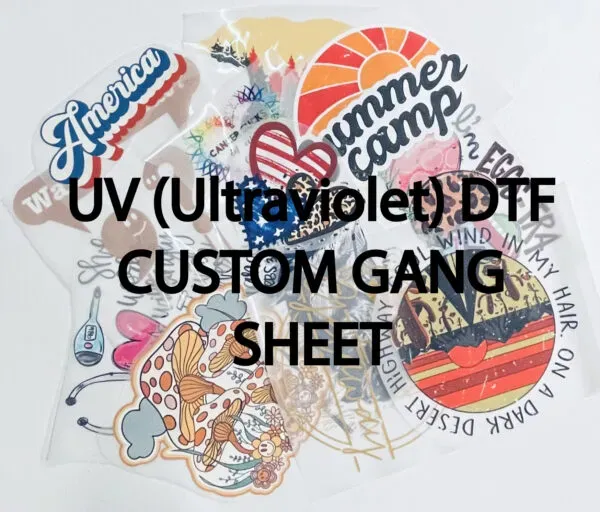In the ever-evolving world of printing, UV DTF gangheet has emerged as a game-changer for industry professionals. This innovative approach combines the benefits of UV printing techniques with direct-to-film (DTF) technology, enabling creators to produce high-quality prints on gang sheets efficiently. For those seeking to maximize productivity while minimizing costs, understanding the principles of gang sheet printing is essential. In this article, we delve into how to choose the best UV DTF gangheet, highlighting key factors that can elevate your printing process and maintain exceptional quality. From exploring DTF printing best practices to understanding the intricacies of how to choose DTF sheets, we provide essential insights for anyone looking to enhance their printing capabilities.
Exploring an advanced method in the realm of printing, the UV DTF gangheet stands out as a vital resource for obtaining clear and vibrant designs. This technique, which employs direct-to-film processes, allows multiple images to be printed simultaneously on a single platform, streamlining workflow and reducing material expenses. By leveraging high-quality gang sheets, individuals can optimize their printing practices while achieving extraordinary results. In this discussion, we will uncover the essentials of selecting the right gang sheet for UV printing, the significance of adhering to DTF printing best practices, and tips on how to choose the most suitable DTF sheets for your specific project needs.
The Evolution of Gang Sheet Printing
Gang sheet printing has revolutionized how printing professionals approach production. Traditionally, print jobs involved creating individual prints, leading to increased costs and inefficiencies. However, the introduction of gang sheets allows multiple designs to be printed simultaneously, making full use of available materials. This innovative technique not only minimizes waste but also increases turnaround times, which is essential in today’s fast-paced market.
The evolution of gang sheet printing has been driven by advancements in direct to film (DTF) technology, alongside improvements in ink formulations. As printers look for ways to optimize their processes, the shift towards DTF gang sheets is apparent. Today’s gang sheets not only provide efficiency but also deliver outstanding quality, ensuring that every print meets the high standards expected by customers. For businesses looking to grow, understanding and implementing gang sheet strategies is a move towards modern printing solutions.
Best UV DTF Gangheet Features to Look For
When choosing the best UV DTF gangheet, several features should be at the top of your checklist. Firstly, material compatibility is crucial. The gang sheet must be specifically designed to handle UV inks, ensuring that colors remain vibrant and adhere properly to the substrate. Look for gang sheets that are formulated to withstand the curing process of UV printers, as this directly influences the durability and quality of the finished prints.
Another important feature is the size and configuration of the gang sheet. A well-sized gang sheet can optimize the use of printer capabilities, allowing for maximum utilization of the print area while maintaining high definition. Additionally, evaluating the printing layout for its potential to reduce waste is essential; creativity in design can elevate print quality while reducing overall costs, making it a key factor in your selection.
Lastly, understanding the kind of substrate you’re printing on is key for UV DTF printing best practices. Different materials respond uniquely to UV inks, affecting the outcome of your prints. Whether you’re printing on textiles or rigid surfaces, selecting a UV DTF gangheet that complements your chosen substrate can dramatically enhance image quality.
Strategies for Successful DTF Printing
To reap the full benefits of DTF printing, adopting strategic practices is essential. One fundamental strategy is to maximize layout efficiency on gang sheets. By meticulously arranging designs to fit as many graphics as possible without overlap, you can optimize the material use and lower costs. Utilizing graphic design software can facilitate this process, allowing printers to visualize and adjust their layouts for the best results.
Additionally, conducting thorough testing before the final print is crucial. Testing various configurations and substrates can reveal the ideal settings for your specific printing needs. This could mean running numerous trial prints to assess color fidelity, adhesion, and overall appearance before committing to full production. By integrating these strategies, printing professionals can ensure they are producing high-quality results every time.
Quality Control in DTF Printing
Quality control is an indispensable component of the DTF printing process. Regular inspections of prints can help catch any issues early on, such as ink inconsistencies or adhesion problems that may affect the final product. By implementing a robust quality control protocol, print shops can reduce waste and ensure that each gang sheet meets the desired specifications before it’s delivered.
Furthermore, investing in training for staff about common pitfalls and best practices can significantly enhance quality assurance processes. When all team members are aware of the standards and checkpoints, the consistency in print quality can be drastically improved. This attention to detail not only elevates the quality of printed outputs but also cultivates trust with clients who expect top-tier outcomes.
Current Trends in UV DTF Printing
Staying updated with current trends in UV DTF printing is crucial for any business looking to thrive. Recent developments have highlighted advancements in ink technologies that increase durability and adhesion, enabling a broader spectrum of applications. For instance, new formulations are designed to enhance flexibility and resistance to wear, facilitating use across various surfaces from textiles to hard goods.
Moreover, as consumers become more environmentally conscious, the demand for sustainable printing solutions rises. Many printing professionals are now seeking eco-friendly inks and materials that do not compromise print quality. Adapting to these trends ensures that businesses not only remain competitive but also align with consumer values, making them more appealing in the modern marketplace.
How to Enhance Your DTF Printing Skills
Improving your skills in DTF printing requires a commitment to continuous learning and experimentation. Attending workshops and industry conferences can provide insights into the latest techniques and technologies in UV DTF printing. Networking with other professionals can also share valuable tips and tricks that enhance overall printing outcomes.
Additionally, practicing designing with gang sheets is an effective way to refine your skills. Using your own designs, experiment with layouts, and test various substrates to see how they respond to UV inks. This hands-on approach will deepen your understanding of the intricacies of DTF printing and lead to better quality prints, ultimately boosting your confidence as a printing professional.
Frequently Asked Questions
What is a UV DTF gangheet and how does it work?
A UV DTF gangheet, or gang sheet, is a printing technique that allows multiple designs to be printed simultaneously on a single sheet using UV printing technologies. This method maximizes efficiency and minimizes material costs, allowing for quicker turnaround times while maintaining high print quality.
How do I choose the right DTF sheets for UV printing?
Choosing the right DTF sheets for UV printing involves ensuring material compatibility with UV inks, selecting the appropriate size according to your printer’s capacity, and confirming the sheets are designed for optimal adhesion and color vibrancy. This can significantly enhance print quality.
What are the best practices for designing UV DTF gang sheets?
To design effective UV DTF gang sheets, arrange graphics to maximize space without sacrificing clarity. Utilize design software for seamless adjustments, conduct test prints to check for color accuracy and adhesion, and implement regular quality control checks to catch defects early.
Why is material compatibility important for UV DTF gang sheets?
Material compatibility is crucial for UV DTF gang sheets as it ensures the sheet can withstand the curing process of UV inks, maintaining color vibrancy and preventing issues like fading or poor adhesion. Using compatible materials leads to higher quality finished prints.
What current trends should I be aware of in UV DTF printing?
Current trends in UV DTF printing include advancements in ink formulations that improve adhesion and durability, expanding application possibilities. Keeping up with these innovations is essential for printers looking to enhance quality and efficiency in their outputs.
How can I optimize my production process with UV DTF gang sheets?
To optimize production with UV DTF gang sheets, focus on thoughtful design layouts, ensure printer and ink compatibility, and conduct testing to identify the best materials. Regularly reviewing the production process can lead to reduced waste and improved print quality.
| Key Point | Details |
|---|---|
| Introduction | The UV DTF gang sheet is crucial for print quality and efficiency. |
| Understanding Gang Sheets | Gang sheets allow multiple designs to be printed simultaneously, reducing costs and maximizing efficiency. |
| Selecting the Right UV DTF Gang Sheet | Consider material compatibility, size, and printer ink compatibility for the best results. |
| Best Practices | Focus on design layout, conduct test prints, and ensure quality control to improve outcomes. |
| Current Trends | Stay updated on advancements in inks and films to enhance print applications. |
Summary
When it comes to the world of printing, selecting the best UV DTF gangheet for your projects is fundamental for achieving superior outputs. This innovative printing solution allows experts to optimize their workflows and improve product quality, thereby enhancing overall productivity. By understanding the intricacies of gang sheets, their compatibility with various inks and printers, and implementing best practices in design and quality control, professionals can ensure seamless performances. As the industry continues to evolve, keeping an eye on the latest trends and technologies will be vital for anyone looking to harness the full potential of UV DTF printing. Overall, the journey towards better prints is significantly influenced by the strategic decisions made regarding UV DTF gangheets.



